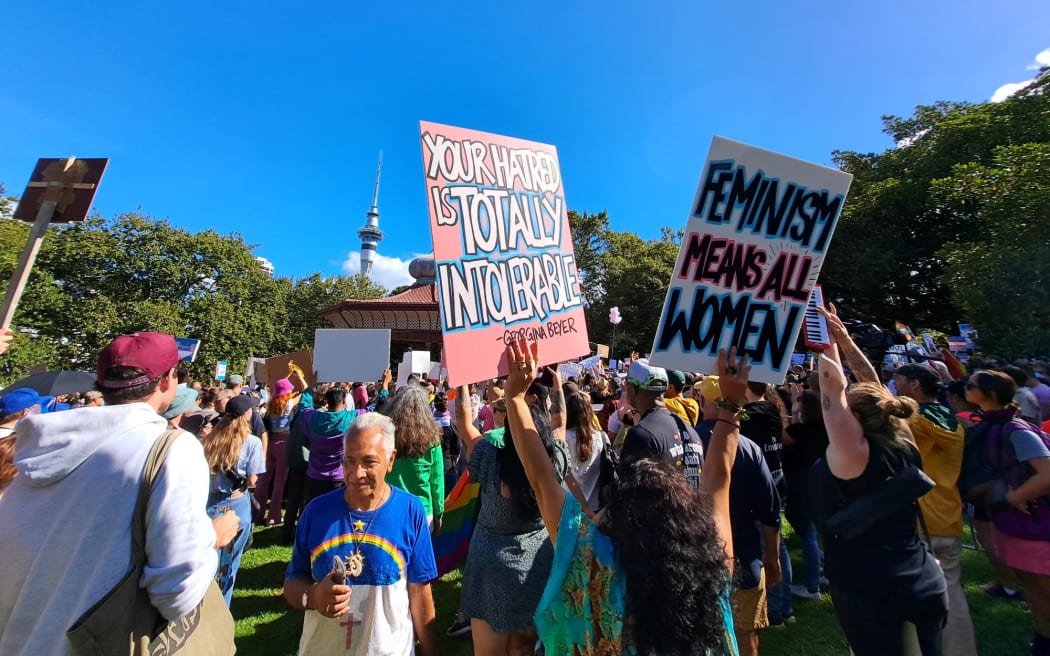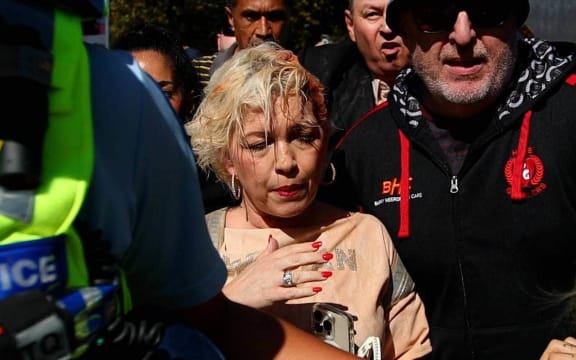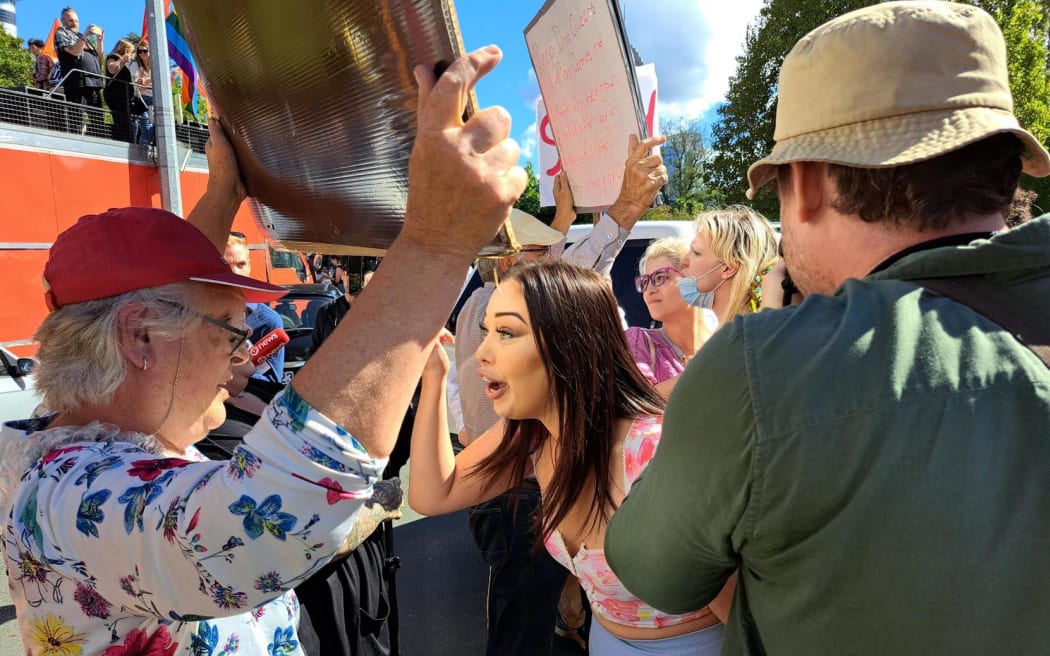
Protestors at the Posie Parker rally in Auckland. Photo: RNZ / Jordan Dunn
The protest that overwhelmed a rally for anti-trans rights activist Kellie-Jay Keen-Minshull in Auckland last weekend was described as out-of-control and violent in some accounts. Two reporters who covered the protest on the ground tell Mediawatch that does not reflect what they saw.
Minutes after the anti-trans rights activist Kellie-Jay Keen-Minshull left Albert Park under police escort last weekend, counter-protesters crowded the band rotunda to have what Auckland Pride director Max Tweedie described as a “trans joy dance party”.
At that point, the protesters’ joy did not seem out-of-step with some of the media coverage of the event.
Much of the early reporting on the counter-protest also painted it as either relatively peaceful or not particularly aggressive compared to other demonstrations like the Parliament occupation. The New Zealand Herald noted some “ugly” confrontations including pushing and shoving between Keen-Minshull’s supporters and counter-protesters.
It also noted Keen-Minshull’s attempts to speak had been drowned out by drums, chants of “go home” and, at one point, a Whitney Houston song playing over loudspeakers.
At The Spinoff, Anna Rawhiti-Connell painted it as an event where “joy trumped fear and a symphony of fearlessness drowned [Keen-Minshull] out”.
Others described an almost entirely positive experience of the protest on social media, with one person calling it a “cacophony of aroha”.
By the end of the weekend, a very different media narrative had taken hold.
Sunday afternoon's Weekend Collective show on Newstalk ZB was the first to open up national talkback lines on the issue. Host Tim Beveridge asked callers whether the outcome of the rally made for a good or bad day for New Zealand.
One caller bemoaned "the shutting down of free speech by the authoritarian left", while another said "women's rights were being suppressed" and one more claimed women were being "kicked to the kerb".
Those callers may have been reading and watching commentators, some local and some overseas, who had painted the protest as violent and out-of-control.
On Saturday night the world's most successful living author, JK Rowling, told her 14 million followers on Twitter the scenes at the Auckland protest were "repellent". She posted dozens of further tweets about it over the following days.
On Interest.co.nz, commentator Chris Trotter described counter-protesters screaming abuse, hurling projectiles, and lashing out at Keen-Minshull – who he called a “terrified rag-doll” with “eyes dulled by the effects of shock” as she was heaved past a crush of fury and hate.
The Free Speech Union compared the protest to the parliament occupation, where bricks were thrown at police and a playground was set on fire.
One of its board members backed a petition calling for one of the counter-protest organisers, Shaneel Lal, to be fired as a Herald columnist.
Another board member – Melissa Derby – liked a tweet calling for Lal to be "locked up" and retweeted one saying the “trans movement” cannot be tolerated in civil society.
The claims of rampant and unchecked violence were boosted by the far-right media outlet Counterspin and the leaders of Voices For Freedom, who were at the protest to support Keen-Minshull.
On The Platform, Sean Plunket on Monday criticised what he called mob violence, and the counter-protesters made him scared for the future of New Zealand.
Plunket went on to say "white woman callers" would be given priority because they had not been protected at the protest on Saturday.
It is unclear whether that was a slip of the tongue, a joke referencing Marama Davidson's well-publicised comments about violence from white men, or if men and women with other skin tones really were shunted down the call queue.
On Today FM's website, Rachel Smalley lamented the counter-protest silencing women.
"None of us are allowed to speak. Women, if they raise their hands to speak, they are silenced and abused," she wrote, before Today FM was taken off-air.
The counter-protest also included plenty of women. It is unclear whether they counted in Smalley’s eyes.
Meanwhile in Britain, Keen-Minshull supporters called for boycotts of New Zealand products and gathered outside the New Zealand High Commission in London to sing protest songs.
Some of the violent incidents commentators cited were genuine.
Trans rights advocate Eli Rubashkyn poured tomato juice on Keen-Minshull's head. She has been charged with common assault and told Stuff’s podcast Newsable this week that she did not regret it and would face the consequences.

Posie Parker said she was “frightened” after she was doused with tomato juice. Photo: Stuff / Chris McKeen
At the more serious end of the scale, one video shows an elderly woman punched in the face after an altercation with what appears to be a counter-protester.
Other evidence cited for the protest’s violence was more questionable.
A video clip of a man being shoved by a drag queen went viral among trans rights opponents.
But it was shorn of context. The full video of the encounter shows the man grabbing a warden trying to keep protesters in line by the neck. The shove came afterward, as the drag queen tried to push him away from the scene of the attack.
Another widely-shared photo shows Keen-Minshull’s face close up with some hands around her neck, and an object held by a protester close to her throat. JK Rowling and others implied on social media Keen-Minshull was in danger at the time.
In fact the hands belonged to one of her security guards and the object close to her neck was a phone.
JK Rowling also posted a picture of a man getting into an angry verbal altercation, along with a quote implying he was "violent and contemptible". Her tweet was deleted when it emerged the man was part of Keen-Minshull’s own security team.
Isaac Davison and Katie Harris covered the event for the New Zealand Herald.

Opposing views in confrontation at the Posie Parker rally. Photo: RNZ / Jordan Dunn
Davison said it had been surreal watching some of the coverage of the protest, particularly on social media and in overseas news outlets.
"It took on a life of its own and got further and further removed from what that protest was like," he told Mediawatch.
"When you see that you agonise over 'did I get this right' and 'was I fair about it' and 'did I miss something?'" he said.
"But when you're on the ground and there in the thick of things, I think what we reported was right. A lot of commentary was from people who were removed from it or maybe had an interest in portraying the protest in a way that it wasn't."
Harris said the reaction to the protest had been a lesson in how misleading or one-sided narratives can be shaped online, or by media with an agenda.
"I do think a large amount of that was coming from overseas news outlets. This kind of thing is more toxic in the UK, and the media over there are more one-sided in some ways. There's also a lot of misinformation going around on social media," she said.
"It is really hard with social media because either side might be pushing one narrative and you don't know what's true and what's not true. I don't think this was the 2000-person mob that some outlets in the UK have described," she said.
Davison was stationed closer to Keen-Minshull when the confrontation around the rotunda took place.
But his experience of that did not match the condemnations in some media outlets and online.
"I go back to my strong feeling I had at the time that it was a rowdy protest, but not a violent one," he said.
"There were some nasty incidents on the margins, but overwhelmingly that was not what the protest was like."

